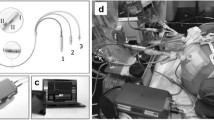Summary
Cortical blood flow (CoBF) monitoring with a thermal diffusion flow probe was performed during the clipping of aneurysms of the ICA and MCA regions, on a series of patients during the acute stage of subarachnoid haemorrhage. Emphasis was placed on the CoBF recovery after temporary clip release. Since the absolute value in this technique is unreliable, recovery of blood flow after temporary clipping is represented as %CoBF according to the following equation: %CoBF recovery = (CoBFpost-CoBFintra)/(CoBFpre-CoBFintra)
Presumably, this parameter checks the patency of the concerned cerebral vessels during clipping and/or release. Percent recovery of more than 100%, indicating postischaemic reactive hyperaemia, was observed immediately after release of the temporary clips in 8 of the 9 cases evaluated. In one case, with prolonged temporary clipping (37 min), no immediate recovery was observed after clip release, suggesting no-reflow phenomenon. The value slowly recovered after local administration of papaverin and returned to the pre-occlusion level within 20 minutes.
Thermal diffusion CoBF monitoring may be useful in detecting the possible no-reflow phenomenon, that may lead to ischaemic complication, even after successful aneurysm clipping.
Similar content being viewed by others
References
Ames A, Wright LW, Kowada M,et al (1968) Cerebral ischemia II: the no reflow phenomenon. Am J Pathol 52: 437–453
Cantu RC, Ames A III (1969) Experimental prevention of cerebral vasculature obstruction produced by ischemia. J Neurosurg 30: 50–54
Carter LP, Atkinson JR (1973) Autoregulation and hyperemia of cerebral blood flow as evaluated by thermal diffusion. Stroke 4: 917–922
Carter LP, Erspamer R, Bro WJ (1981) Cortical blood flow: thermal diffusion vs isotope clearance. Stroke 12: 513–518
Carter LP, Erspamer R, White WL,et al (1982) Cortical blood flow during craniotomy for aneurysm. Surg Neurol 17: 204–208
Carter LP, White WL, Atkinson JR (1978) Regional cortical blood flow at craniotomy. Neurosurgery 2: 223–229
Fischer EG, Ames A III, Lorenzo AV (1979) Cerebral blood flow immediately following brief circulatory stasis. Stroke 10: 423–427
Fischer EG, Ames A III (1972) Studies on mechanisms of impairment of cerebral circulation following ischemia: effect of hemodilution and perfusion pressure. Stroke 3: 538–542
Fischer EG (1973) Impaired perfusion following cerebrovascular stasis. A review. Arch Neurol 29: 361–366
Ginsberg MD, Budd WW, Welsh FA (1978) Diffuse cerebral ischemia in the cat: I. Local blood flow during severe ischemia and recirculation. Ann Neurol 3: 482–492
Gouley JK, Heistad DD (1984) Characteristics of reactive hyperemia in the cerebral circulation. Am J Physiol 246: H52–58
Häggendal E, Löfgren NJ, Nilsson NJ,et al (1970) Prolonged hyperemia after periods of increased cerebrospinal fluid pressure in dogs. Acta Physiol Scand 79: 272–279
Hossmann KA, Lechtape-Grüter H, Hossmann V (1973) The role of cerebral blood flow for the recovery of the brain after prolonged ischemia. Z Neurol 204: 281–299
Hossmann KA (1993) Ischemia-mediated neuronal injury. Resuscitation 26: 225–235
Jabre A, Symon L (1987) Temporary vascular occlusion during aneurysm surgery. Surg Neurol 27: 47–63
Kagström E, Smith ML, Siesjö BK (1983) Local cerebral blood flow in the recovery period following complete ischemia in the rat. J Cereb Blood Flow Metab 13: 170–182
Ohmoto T, Nagao S, Mino S,et al (1991) Monitoring of cortical blood flow during temporary arterial occlusion in aneurysm surgery by the thermal diffusion method. Neurosurgery 28: 49–55
Okada Y, Copland BR, Mori E,et al (1994) P-selectin and intercellular adhesion molecule-1 expression after focal brain ischemia and reperfusion. Stroke 25: 202–211
Tenjin H, Hirakawa K, Mizukawa N,et al (1988) Dysautoregulation in patients with ruptured aneurysms: cerebral blood flow measurements obtained during surgery by a temperature-controlled thermoelectrical method. Neurosurgery 23: 705–709
Thomas WS, Mori E, Copeland BR,et al (1993) Tissue factor contributes to microvascular defects after focal cerebral ischemia. Stroke 24: 847–853
Yonekawa Y, Marugg R, Imhof HG,et al (1995) Actual initial management of subarachnoid hemorrhage. Praxis 84: 667–674
Author information
Authors and Affiliations
Rights and permissions
About this article
Cite this article
Ogata, N., Fournier, J.Y., Imhof, H.G. et al. Thermal diffusion blood flow monitoring during aneurysm surgery. Acta neurochir 138, 726–731 (1996). https://doi.org/10.1007/BF01411479
Issue Date:
DOI: https://doi.org/10.1007/BF01411479




